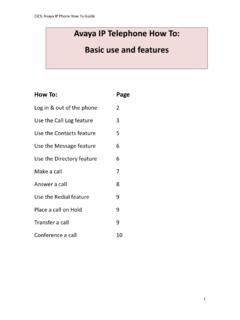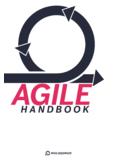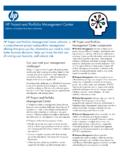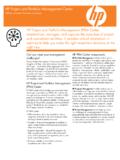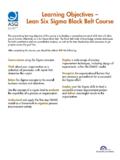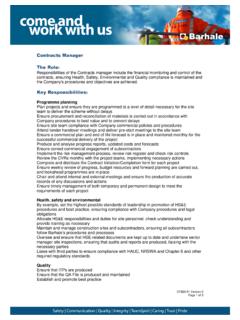Transcription of Project Start-up Toolkit - University of Sheffield
1 Project Start-up ToolkitCiCS Programme & Project UnitContents1. Introduction 1 2. Project Start-up Flowchart 2 3. Project Start-up Some Aspects to Consider 3 4. Working With People 7 5. Project Start-up Meeting 11 6. Housekeeping 13 7. Outputs of the Startup Process 14 8. Further assistance 15 Appendix 1: Project Approval 16 did your Project come from? Was A response to a business need? Driven by technological change? A desire to maximise use of services we already have? Commercial pressures. Competition (they re doing it so we have to)?
2 Self-promoted your very own bright idea?Wherever it was, at the end of the day someone has decided that we need a Project , and it is fallen to you to kick that Project off. You are probably feeling a little nervous at this stage - will your Project succeed? Is your heart really in it anyway it might be so much easier to keep your head down and carry on with business as usual mightn t it?With this Toolkit , we hope to allay some of these fears and give you some of the tools you need to get the Project off the ground. Once it is up and running, you re probably going to need some more help, and that s what PPU is here for, and our Support for Project Managers website ..but we ll get to that later. Project Start-up is marked by the completion of three main documents - the Project Definition, the Risk Log and the Project Plan. However, this is a lot more than a form-filling exercise the work that you do to prepare these documents defines the aims and objectives of the Project and the course it will take.
3 We hope the Toolkit will help you take a step back and consider the Project in all its aspects before you embark upon the Golden Road that will take you a successful completion. The Flow-chart on the next page suggests a route through from initial conception to Active Project stage. For more on Project Approval see Appendix of Start-up Flowchart20-Jul-102 of Start-up Some Aspects to Consider Support for youPPU offer a range of documents to help you get started. In the M:\Projects\PROJECTS SUPPORT\Standard Documents area you will find the following templates and advice notes: Project Definition & Notes Project Managers Diary Project Plan Project Web Page Quality and Test Log & Notes Risk LogThe CiCS Projects website offers further assistance at including: Planning Toolkit Benefits Management Toolkit for Project Managers For further assistance please contact the Programme and Project Unit by phone, by e-mail at or come to 340 Glossop your Project is up and running PPU will offer you regular 1:1 sessions to give you an opportunity to talk about the Project , bounce ideas around and feed back on issues.
4 Outline RequirementsBear in mind that when you propose a Project what you are really trying to do is define where you want to be and how you intend to get there. A Project proposal that merely says install piece of software x will not gain approval unless the reasons for selecting that particular piece of software are fully the procedures for selecting that particular solution have already been followed, then it may be perfectly reasonable to specify the solution you wish to adopt - in other cases you should merely specify what you want to achieve and what the benefits of that objective are likely to be, not the deliverables themselves. At the Project Definition stage you will have to define objectives that are SMART - Specific, Measurable, Agreed, Realistic and Time-based - but not yet. What have you done to gather user requirements, and limit user expectations? Benefits and RisksBenefitsIf a Project doesn t deliver benefits it is not worth doing.
5 The benefits you identify should be owned by somebody on the Project group normally the customer although you do not have to specify this at this stage. The benefits should be organisational and should be distinguishable from features for example XYZ Capable is not a reason to do something, but makes service available off-site may be. Benefits are all about making sure full advantage will be taken of the Project s deliverables. Benefits should have an owner who is responsible for benefits delivery, making sure the new capabilities the Project has delivered will be you can answer the following set of questions you will be well on the way to understanding the potential benefits the Project can bring. 1)Who will be affected by the requested change (stakeholders)?2)Have they been consulted?3)What value (benefits) will the change bring (doesn t have to be financial): for you?
6 For the University ? for the other stakeholders?20-Jul-103 of 164)When (quarter or year) would the benefits be realised?5)Will the benefits also depend on other changes?6)What are these changes?7)Who owns these changes?8)What are the risks of not achieving the benefits?9)How will you know it has been successful (measures)?The Benefits Management Toolkit for Project Managers document will help you in this - the great imponderable. You should identify the risks you can, but be aware that there are other risks out there that may not be apparent at first. Also be wary of over-stating the risks your stakeholder may well say, well if it s that risky, why bother? Risks can be positive as well as negative, and the perception of a risk may vary according to the perception of the stakeholder. Having identified the risks, you have to ask yourself how likely are these risks? What will the impact of the risks be, if they do occur?
7 Use the Risk Log template to help identify the highest priority risks and what you need to do about it. Looking at the Project ProposalMost projects are approved on the basis of a Project Proposal. If your Project is one of these you are off to a flying start with the Project of Non-ImplementationThis should give an indication of what would happen if we continued with the do nothing option. ProposalThis is the kernel of the Project . What does the Project actually want to do, and how can it be done? There may be alternative approaches defined if not it is still worth considering & Time estimates Costs are very difficult to estimate in a University environment. Where there is software or hardware to be bought, it s fairly easy to get a costing. However, very often you will be using existing infrastructure to develop a new system. The proportion of the costs of the entire infrastructure you will be using is hard to quantify, and the developers you are working with will find it very hard to tell you how long the system they are working on will take to complete, so person-hour figures are hard to obtain.
8 The only time that estimates for projects are accurate is at the end hopefully the proposer has given it their best shot. The costs should have included a proportion of the schedule for roll-out, documentation, change management and so on this is usually much more arduous than expected. In costs, if a resource is needed to look after the system once it is rolled out, This should have been stated clearly. Is your Project a replacement for an existing system, in which case the people currently looking after the system will need to be retrained, or is it a new system requiring a completely new resource? If so, where is this new resource going to come from? You need to make the CiCS Service Strategy Board aware if this is an Aspects of the Project DefinitionThe Project Definition format was rationalised in 2009 to make it clearer and easier to use. There are ' Project Definition Notes' on the website which will help you with drafting Service Level Agreements, scoping is as much about what you are not going to do as what you are.
9 You need to take a long hard look at what it is going to be feasible to do with the resources you have and the time you have available. Beware scope creep! As the Project progresses you may well find that there are other tasks that follow on from your Project and you might want to take them on, or you might have to do them if your Project is going to be a 20-Jul-104 of 16success (an infrastructure improvement to support your new software for example) Here you need to use your judgement can you afford to take this extra task on, or can you afford not to? Bear in mind that if the additional work is going to need another Project , there is going to be a high administrative overhead in setting up and running it and it might actually be less work to include the extra work in the Scope to save you having to go through the whole thing the product you propose to deliver meet University standards, inter-platform operability, accessibility?
10 How does your Project fit in to the University s strategy? Is it aligned with our aims and objectives? It may seem a long way from the installation of a widget to developing our international standing, but our web-based systems are available world-wide and have to be fit for purpose. See Appendix 1 for more about the CiCS portfolio of projects. Time constraintsUniversity business is cyclical, based on the Academic Calendar. For many projects there are only certain periods when work can be done. You may need to get the Project completed for registration, or you may find that no work can be done during the registration period as staff are busy elsewhere. There are other periods when certain sectors of personnel are unavailable, for example the exams marking period. It may be unwise to roll out a new product during these periods. This should be discussed with everyone involved, including the customers who will probably be doing the testing and undertaking the your Project being driven by an external deadline, or are you able to set the deadline yourself?
